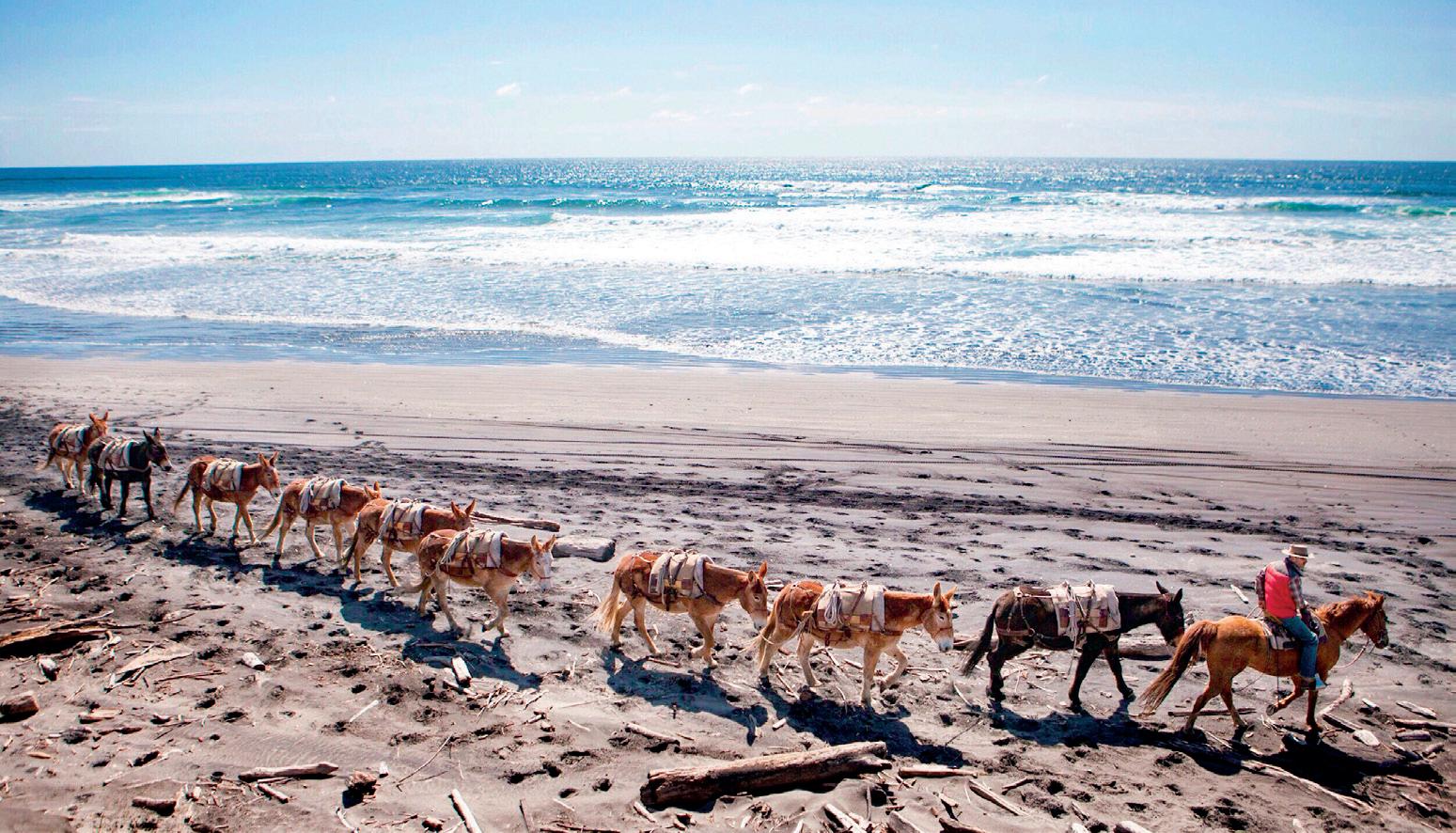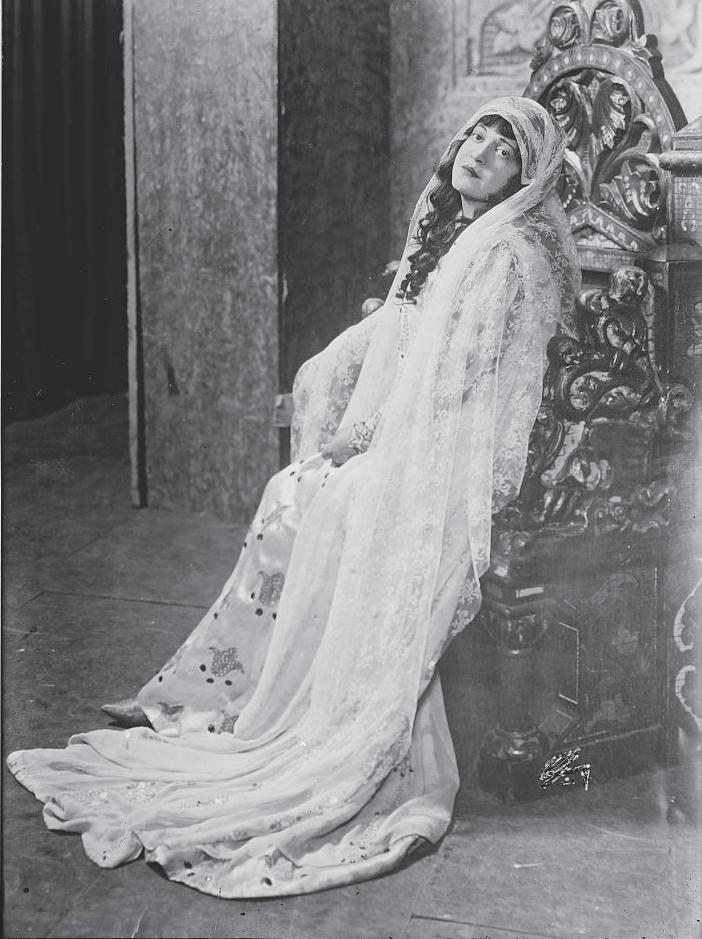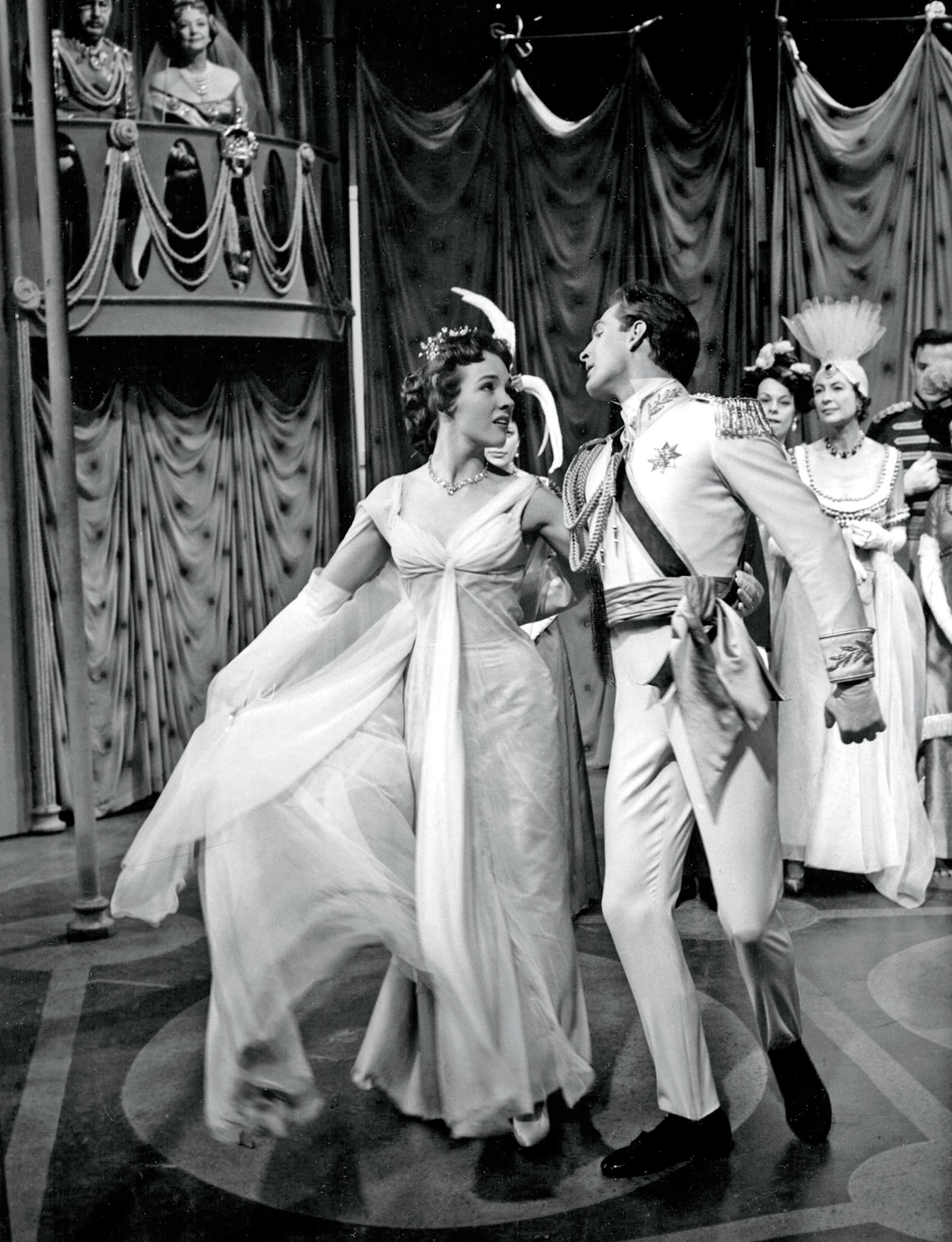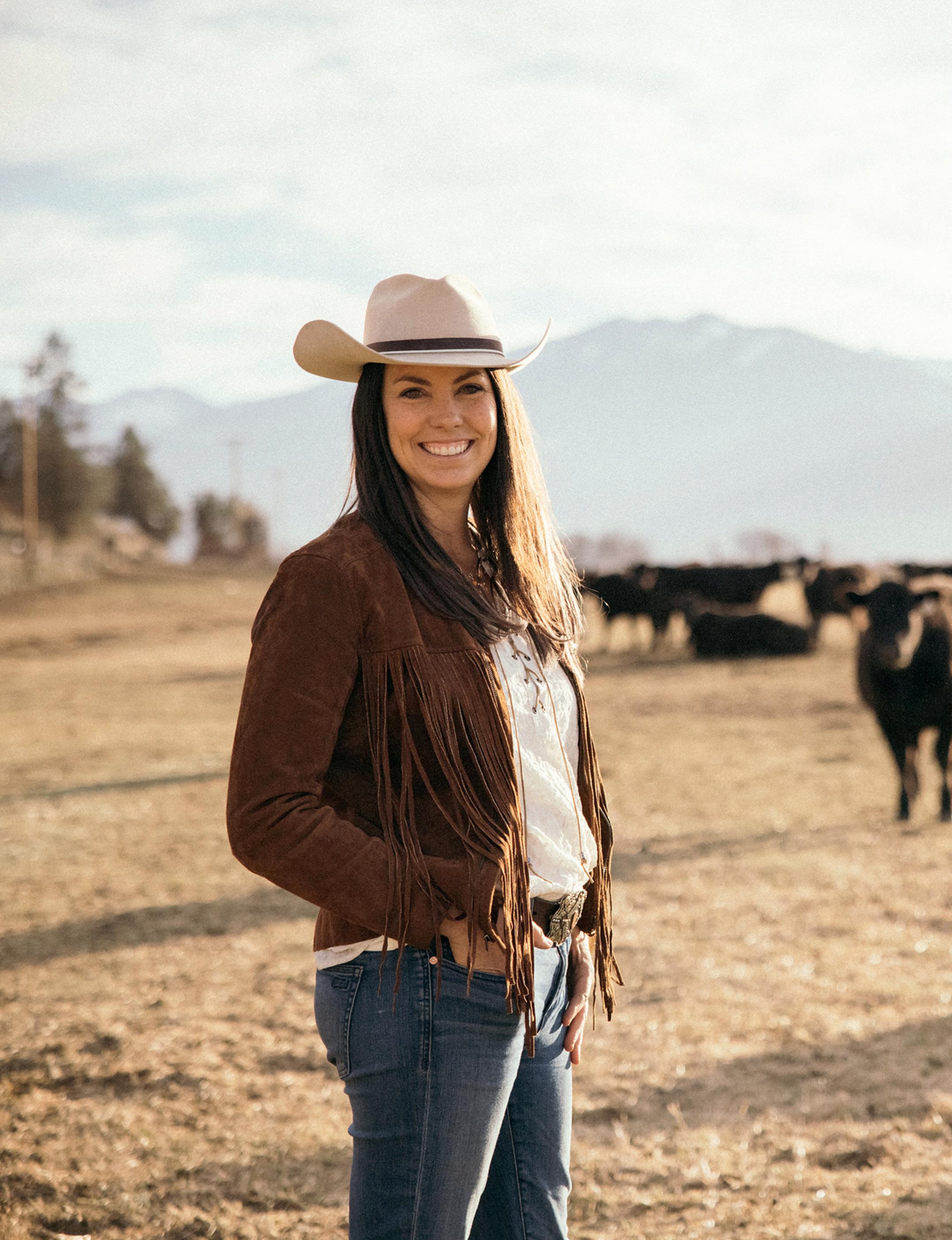American Essence
FOR EVERYONE WHO LOVES THIS COUNTRY
The Meteoric Rise of Rosa Ponselle Plant Power
Starting in vaudeville, she became one of the most lauded singers in opera history
Houseplants changed Hilton Carter’s life; now, he’s their loudest spokesperson
With hundreds of gigs on his resume, Mike Rowe has charted a path to passion, pride, and prosperity—through the skilled trades

AMERICA’S FAVORITE APPRENTICE
American Essence APRIL 2023 APRIL 2023
VOLUME 3 | ISSUE 4 LimitedPreview ofSelectedContent
The Gladness of Nature
By William Cullen Bryant
Is this a time to be cloudy and sad,
When our mother Nature laughs around; When even the deep blue heavens look glad,
And gladness breathes from the blossoming ground?
There are notes of joy from the hang-bird and wren,
And the gossip of swallows through all the sky; The ground-squirrel gayly chirps by his den,
And the wilding bee hums merrily by.
The clouds are at play in the azure space,
And their shadows at play on the bright green vale, And here they stretch to the frolic chase,
And there they roll on the easy gale.
There’s a dance of leaves in that aspen bower,
There’s a titter of winds in that beechen tree, There’s a smile on the fruit, and a smile on the flower,
And a laugh from the brook that runs to the sea.
And look at the broad-faced sun, how he smiles
On the dewy earth that smiles in his ray, On the leaping waters and gay young isles;
Ay, look, and he’ll smile thy gloom away.

A waterfall flows through Umnak, one of the islands in the Aleutian archipelago of Alaska.

Contents
Features
8 | Into the Wild Can exploring the wilderness be a life-changing experience? Mule packer Chris Eyer gives a resounding yes.
12 | Pillars of Resilience

Marine veteran Chad Robichaux forges an approach to support veterans’ recovery from trauma.
20 | The Charming Pat Boone He captured the hearts of many during the 1950s with his sweet voice and family values. Now 88, he still fiercely believes in the power of doing good.
24 | Front-Rowe Seat
Viewers labor vicariously in “dirty jobs” through America’s favorite apprentice, Mike Rowe.

32 | Why I Love America
A man raised on baseball and patriotism creates nine truisms based on the intrinsic values of America’s pastime.
34 | Family Roots
A family legend recalls how cousin Chuck caught America’s most wanted and protected the vulnerable.
36 | Aging With Wisdom
Actress Suzanne Somers on embracing the future with gratitude and grace.
History
38 | Wars and Westerns
Actor John Wayne became the face of America by starring in films that promoted the nation’s greatness.
44 | Creating Charlie Brown
Charles Schulz’s beloved “Peanuts” comic strip was the result of decades of dreams and perseverance.
48 | The Patriots of April
The first shot fired at Lexington Green signaled the birth of America’s revolution.
52 | ‘Our American Rose’
Singing to pay off her parents’ debt, Rosa Ponselle was an untrained vocalist who became the nation’s best-loved prima donna.
56 | Quick-Witted Quips

Some of our nation’s leaders were quick on the draw with their sharp wits.
58 | Golden Age of Musicals
Blending poetic lyrics with a sophisticated plot, Rodgers and Hammerstein redefined the era of American musicals.
62 | Book Recommender
Meticulously researched, “Union General” is the first biography of the nearly forgotten Civil War general who never lost a battle.
64 74
Lifestyle



 64 | Mary Had a Small Business Empire Five Marys Farms, an 1,800-acre family ranch in Northern California, is powered by entrepreneurial spirit.
74 | The Life-Changing Power of Houseplants
Interior stylist Hilton Carter on making space in our homes and hearts for houseplants.
82 | America in Bloom
Where and when to see the country’s most spectacular wildflowers.
84 | California Cruisin’
64 | Mary Had a Small Business Empire Five Marys Farms, an 1,800-acre family ranch in Northern California, is powered by entrepreneurial spirit.
74 | The Life-Changing Power of Houseplants
Interior stylist Hilton Carter on making space in our homes and hearts for houseplants.
82 | America in Bloom
Where and when to see the country’s most spectacular wildflowers.
84 | California Cruisin’
24 52 8
From ancient redwoods to a hilltop castle, the quintessential road trip delivers breathtaking sights at every turn.
96 | Parting Thoughts
Karina Brez, equestrian jeweler and former Miss Florida USA, shares the beauty of her craft.
Out in the Rockies With Mule Packer Chris Eyer

The wonders and challenges of a little-known occupation in the wilderness
WRITTEN BY Annie Wu
Chris Eyer and his pack of mules travel through the Danaher Meadows in the Bob Marshall Wilderness region.
Out in the roughly 112 million acres of land that are designated as “wilderness areas” by the federal Wilderness Act of 1964, no motorized vehicles or “mechanical transport” are allowed to operate—not even a wheelbarrow. That’s where mule packer
Chris Eyer comes in. Together with his pack of 10 to 15 hardworking animals, he helps to transport supplies for the U.S. Forest Service and outdoor guides who bring people out on wilderness trips. It was a lifelong dream: When he was about 14, he went on a mountaineering school trip to the Sierras in California, and he spotted a man with a pack of mules. That moment was seared into his mind and sparked a desire to one day embrace the Wild West archetype.
Along the way, Eyer served in the Marine Corps during the first Gulf War (“I had a strong sense of garden variety patriotism and a real love for freedom”), went to university, started an electrical contracting company, and began crafting saddles. The mule packing is mostly a volunteering endeavor born out of the love for the outdoors. He lives in a pocket of wilderness in Ovando, Montana, nestled in the northern Rocky Mountains, known as the Bob Marshall Wilderness Complex (“I live in a spot where I can ride out my front door and go all the way to Canada”). Today, he sits on the board of directors for a foundation that maintains the wilderness complex and runs programs that bring people to explore the area.
Eyer spoke to American Essence about what mule packing entails and the deeper meaning behind connecting with nature.

American Essence: What is a typical day like for you?
Chris Eyer: I would wake up at 5 a.m. I would have all of my loads already made. So everything would be all put together and wrapped up in what we call manties [tarps]. I make coffee and start to wrangle all my stocks, get them loaded up into the trailer, and I’d head to the trailhead. I drive up there, unload, and then I go through a process of brushing everyone, making sure everyone is sound and looking good, put pads on them, saddle them all, get them all ready to go. I take these heavy loads, which are usually about 75 to 90 pounds per side, so anywhere from 150 to 180 pounds per animal, which for them is really not heavy. We always keep it to less than 20 percent of their body weight. If everything goes really smoothly,
I’ll be on the trail by 9 a.m. A typical day for me would be riding anywhere from 18 to 25 miles, at which point I would stop and drop all the loads. And then I would take all the saddles off. Then I would start the process of turning my stock loose for the night, so that they can graze and water all night unimpeded.
I’m normally in bed asleep by 8:15. And then I wake up in the morning and do it all again, whether I come out empty or move heavy things to the next destination.
ISSUE 4 | APRIL 2023 5
The Wild West | Features
6 AMERICAN ESSENCE
This page is not in the preview.
not included preview.
ISSUE 4 | APRIL 2023 7
Pat Boone A Force for Good

Throughout the years, 1950s crooner Pat Boone has held fast to the importance of family values
“Ionce shook hands with Pat Boone and my whole right side sobered up,” the actor and singer Dean Martin once said.
Call it the “Pat Boone Effect.”
Example: In 1997, hard rock and heavy metal were at their peak. Their sound was the
epitome of doom, their lyrics the essence of defeat. Enter an artist from the ’50s and early ’60s, with 38 Top 40 hits to his credit, a singer known for tuneful songs, sung in the smoothest possible way—the very antithesis of hard rock/heavy metal—Pat Boone.
The album, “In a Metal Mood: No More Mr.
8 AMERICAN ESSENCE
WRITTEN BY Kenneth LaFave PHOTOGRAPHED BY John Fredricks
Nice Guy,” featured Boone’s crooner vocal stylings against a lush background of big band saxophones and brass sections. A complete deconstruction of the hard rock/metal genre, “In a Metal Mood” uncovered surprising melodic richness in such unlikely sources as Ozzy Osbourne, AC/DC, Alice Cooper, and Deep Purple. Boone’s version of Deep Purple’s “Smoke on the Water” married the song’s opening guitar riff to a salvo of trumpets, while Boone’s heartfelt delivery gave new life to the dismal lyrics.
Heavy metal didn’t have a chance against the “Pat Boone Effect” and its founding creed: Everything, even the onset of the darkest conditions, can be resisted and tamed. The “Pat Boone Effect” continues today, as its namesake writes books, makes movies, and finds new songs to sing at the age of 88.
An Icon of the ’50s Pat Boone was long ago a name to speak in the same breath as Elvis Presley. In the ’50s, the two of them vied for the top of the pop charts, with Boone often winning. A writer for Time Magazine extolled the young phenom dressed in white shoes in a 1956 article: “Pat Boone, 22, was just another hillbilly singer from Nashville 18 months ago. Today, nobody who hears him in person ever hears the first or last few robust notes—they are always drowned in squeals of bobby-sox delight.” In addition to recording those 38 Top 40 hits between 1955 and 1963 (13 of them gold singles), Boone acted in more than a dozen movies, including “Journey to the Center of the Earth” and the 1962 remake of

Rodgers and Hammerstein’s “State Fair.”
Along the way, he exemplified a pristine image of restraint and hard work. In a lecture to young people, Boone once warned that “kissing for fun is like lighting a lovely candle in a room full of dynamite.” Unwilling to exploit what he assumed was temporary fame, Boone got his bachelor’s degree from Columbia University in 1958, the same year his biggest single hit, “Love Letters in the Sand,” came out, with the intent of becoming a teacher. But fame persisted, allowing him to marry his sweetheart, Shirley, who would be his wife for more than 60 years until her passing in 2020.
And then—the world stopped turning and commenced to spin in the opposite direction. In 1964, the year Boone turned 30, the British invasion brought the Beatles and the Rolling Stones to American shores, and in their wake, a striking change in the cultural weather.
“Drugs and promiscuous sex,” Boone answers immediately to the question, “What prompted the cultural changes of the mid- to late ’60s?” Whatever it was, the change meant that Boone’s milk-and-cookies image suddenly became yesterday’s newspapers. So he moved on, never changing his beliefs nor his singing style, and never judging the new wave (he called Alice Cooper and John Lennon friends), but persisting. He continued to perform and record, finding an audience just outside the one that surfed the mainstream, while tilting occasionally against contemporary culture in a semi-humorous mode that kept one second-guessing: Was he serious about those metal covers, or was that an elaborate joke to expose the thinness of the material? Boone never quite gave a straight answer.
ISSUE 4 | APRIL 2023 9
LEFT Pat Boone in his sunny West Hollywood office.
ABOVE Boone (C) with “American Bandstand” host Dick Clark (L) and pianist Jerry Lee Lewis.
Entertainers | Features
10 AMERICAN ESSENCE
This page is not in the preview.
not included preview.
ISSUE 4 | APRIL 2023 11

12 AMERICAN ESSENCE
Mike Rowe Gives Relationship (and Job) Advice
Years ago, Rowe wrote a Facebook post, which made the rounds online, about a good friend of his. This woman had been single her whole life and could not understand why. She was attractive and successful. Rowe suggested a dating service but she said no. He suggested she branch out across town, and try the museums, libraries, bars, and restaurants there. She declined again.
He said: “You’re not only looking for your soulmate; you’re looking for your soulmate in your own zip code. You’ve got a long list of qualifications: what they should look like, how much money they should make, how they should dress, where they should be from. So you just got all of these obstacles that you’ve put between yourself and the person who you believe can make you happy.
“And we do the same thing with work. We identify the job that’s going to make us happy, get the certification or degrees that we need, line up the interviews, etc., [but] we’ve got it backwards. We ask kids to imagine the job they want, long before they’re capable of doing that, and really, in many cases, before they have a good understanding of what their actual abilities are.”
Just as it happened to him, “you might realize that the thing you prepared yourself for is simply not the thing you’re going to do.”
“Everybody wants job satisfaction, and everybody wants happiness in their personal life, but if you start your quest with the notion that there’s a dream job, and you can’t be happy unless you get that job, it’s going to be a hard road—just as it’s going to be very difficult to find happiness in your personal life if you think there’s only one person on the planet walking around who’s capable of making you feel that way.”
Everyone Rowe met on “Dirty Jobs” was passionate, but few were doing the job they had in mind when they were young adults.
As Rowe says: “Don’t follow your passion— bring it with you.”

ISSUE 4 | APRIL 2023 13
14 AMERICAN ESSENCE
This page is not in the preview.
not included preview.
ISSUE 4 | APRIL 2023 15
John Wayne An American Icon
From his 1939 breakout role to his last film, the Hollywood star stood for and exemplified his country
Rarely is a man remembered for who he was when he was so overshadowed by what he did. In the case of John Wayne, however, who he was and what he did were one and the same.

John Wayne, born Marion Robert Morrison on May 26, 1907, in the very small Iowa town of Winterset, became one of the, if not the, most iconic actors of the 20th century. At 13 pounds, he was born to become a large man, destined for grand entrances and memorable exits. He was the eldest child of the Morrisons, a marriage that was etched with struggles, insults, and uncertainties. The family was poor and moved a lot, eventually landing in California in 1914.
Out in the farmlands and small towns of his
upbringing, he learned how to handle guns, having to protect his father from rattlesnakes while working untamed land. He learned to ride horses. He perfected his reading as he went through the Sears catalogs cover to cover, noting each item he wished he could afford. He learned the idea of hard work, even when it wasn’t profitable, something his father consistently experienced and was reminded of just as often by his mother. He honored both his parents, but he loved his father.
Wayne grew up strong and tall, suitable for an athletic career. His athleticism landed him a football scholarship to the University of Southern California in the fall of
WRITTEN BY Dustin Bass
vvv
“He has given much to America. And he has given to the whole world what an American is supposed to be like.”
—ELIZABETH TAYLOR,
ACTRESS
RIGHT Wayne in the 1940 film “Dark Command.”
16 AMERICAN ESSENCE
FAR RIGHT A promotional still from the 1939 film “Stagecoach,” originally published on the front cover of the National Board of Review magazine.
1925. While attending school, he worked on movie sets as a prop man and was at times a film extra, typically a football player. During this time, he met the already famous and successful film director John Ford. While bodysurfing on the California coast, Wayne injured his shoulder and lost his scholarship. His football playing days were over, but he was still tall, dark, and handsome, and he decided to join the “swing gang” at Fox Film Corporation moving props.
His relationship with Ford blossomed. The two were opposite in nearly every way, but they attracted, as opposites sometimes do. Ford and Wayne developed a kind of father-son relationship, as Wayne would often call Ford “Coach” and “Pappy.” Ford would be credited with giving Wayne his big break—twice.
A Break and a Name
Ford introduced the young actor to director Raoul Walsh, who decided to have him star in his 1930 epic Western “The Big Trail.” The film was a flop at the box office, though in defense of the film, the Great Depression had just begun. During the filming, however, the studio executives decided that “Marion” was not much of a name for a leading man. Anthony Wayne, after the Revolutionary War general, was considered. Anthony didn’t work either. One of the executives suggested John. When the film was released, his new name was on the posters. Much like his nickname “Duke” was given him by local firemen, his new name, bestowed upon him by others, stuck throughout his life.
A new name and a starring role, however,

America’s Leading Man | History
17 ISSUE 4 | APRIL 2023
would hardly change his film career. Throughout the 1930s, Wayne was relegated to B Westerns. As he ascended from his 20s into his 30s, he used his time wisely to perfect his on-screen persona—a persona that he assimilated off-screen as well. His choice of wardrobe, his walk, his fighting style were all tailored for himself by himself. The Duke was an icon in the making, and the making was all his creation. He just needed a true opportunity to showcase it.
A Memorable Entrance
That opportunity arrived in 1939 when Ford chose Wayne to star in his Western film “Stagecoach.” The director had always been a believer in Wayne. The young actor had proven to be a hard worker, receptive to directorial guidance, and willing to do many of his own stunts. Along with that, he was 6 feet, 3 inches tall, with a broad-shouldered frame, blue eyes that showed gray on the silver screen, and a strong nose and jawline. His
acting also came across honest, as if he was speaking directly to the person in the audience. There was a magnetic pull with Wayne, and Ford decided to do all he could in his film to draw viewers to him.
Wayne was a familiar name and face for moviegoers, having already appeared in 80 films by this time. Familiar, yes. A star, no.
The 1939 film revolves around seven passengers trying to get from one town to the next while trying to avoid the inevitable Indian attack. Nearly 85 years removed, “Stagecoach” remains one of the great Westerns. The movie did more than tell a great story. It did something more important. It introduced the world to John Wayne. Eighteen minutes go by before Wayne makes his entrance in the film, and it is an entrance that was created specifically for the induction of a soon-to-be American icon.
In a wide shot, the stagecoach rides up a slight incline when suddenly there is a gunshot. The stagecoach comes to an

History | America’s Leading Man
18 AMERICAN ESSENCE
abrupt halt. Starting with what is known as a cowboy shot (pioneered by Ford and also known as the American shot), the camera moves in for a close-up of Wayne, who twirls his Winchester rifle. The shot starts in focus, slightly goes out of focus as it moves toward the actor, and then finishes in focus. The actor stands majestically wearing a cowboy hat and neckerchief, which would soon become synonymous with Wayne. The shot was out of place not just for the film, but also for Ford. But it was intentional for reasons explained by Scott Eyman in his biography “John Wayne: The Life and Legend.”
“This is less an expertly choreographed entrance for an actor than it is the annunciation of a star.”

America’s Leading Man
From this point on, Wayne would embrace his role as America’s leading man. There were other actors, of course, during his rise. Some on the decline, like Clark Gable and Gary Cooper. Some on the rise, like Cary Grant and Jimmy Stewart. Their greatness in their own ways cannot be diminished. Gable with his force of nature persona. Cooper as an embodiment of honesty and kindness. Grant as the romantic symbol of the 20th century. And Stewart, a personified symbol of truth. But Wayne embodied something else, and yet he was all of these things. He became the face of
LEFT
ABOVE “Stagecoach” was Wayne’s big break into the Hollywood movies, making him one of America’s leading actors and soon to become a star. Theatrical poster for the 1939 American release of “Stagecoach.”
 FAR LEFT Wayne as Sam McCord in the 1960 comedic Western “North to Alaska.”
Cinematographer Bert Glennon (L) and director John Ford on the set of “Stagecoach” in 1939.
FAR LEFT Wayne as Sam McCord in the 1960 comedic Western “North to Alaska.”
Cinematographer Bert Glennon (L) and director John Ford on the set of “Stagecoach” in 1939.
19 ISSUE 4 | APRIL 2023
This page is not in the preview.
not included preview.
21
The Miracle of
Rosa Ponselle
How a reluctant and untrained singer became America’s favorite prima donna
WRITTEN BY Stephen Oles
The year was 1918. Enrico Caruso, the Metropolitan Opera’s biggest star, had chosen a newcomer to be his leading lady. Her name was Rosa Ponselle, she’d just turned 21, and her debut sent critics scurrying for adjectives. She “made a sensational impression and was sensationally received.” She showed “incomparable charm and dramatic ability.” Her voice was “rich, sensuous, … capable of all the lights and shades of operatic expression.”

Who was this musical marvel? Most of the
Met’s singers were foreign-born, and all had learned their art and musicianship in Europe. Few in that opening night audience knew that Rosa had never been to Europe. She’d also
RIGHT Ponselle poses as Mathilde in “William Tell,” a French-language opera by Italian composer Gioachino Rossini. The opera was revived in America at the Metropolitan Opera in 1923, starring Ponselle and Italian tenor Giovanni Martinelli.
22 AMERICAN ESSENCE
History | American Opera
ABOVE Soprano Rosa Ponselle (C) with her sister, mezzosoprano Carmela Anna Ponselle (L), and Edith Prilik, Rosa’s secretary.

This page is not in the preview.
not included preview.

The Pinnacle of
American Musicals
Rodgers and Hammerstein set the stage for the ‘book musical’ and defined the span of Broadway’s golden age
On the evening of March 31, 1943, American musical theater entered its Golden Age. That was the night the curtain at Broadway’s St. James Theatre rose on an old woman churning butter and a cowboy praising the beauty of the morning. It was the night “Oklahoma!” proclaimed the arrival of composer Richard Rodgers and librettist/lyricist Oscar Hammerstein II as a writing team and theatrical force.
The show wasn’t expected to be a hit. “No gags, no girls, no chance,” was the infamous response of a critic who saw “Oklahoma!” in out-of-town previews. Musicals at the time were expected to exhibit a certain degree of glitz that this one lacked. Through the magic of Rodgers’s music and Hammerstein’s words, however, “Oklahoma!” made audiences—and critics—forget all that. It ran for an unprecedented five-plus years.
“Rodgers and Hammerstein,” as the team quickly became known, went on to define the span of the Golden Age they initiated, which for most commentators ends with Hammerstein’s death in 1960. These years, 1943–1960, were the era of the “book musical,” the blending of musical, lyrical, dramatic, and choreographic elements into a seamless whole, each contributing to the tone and meaning of the story. That may seem old-fashioned in a time of jukebox musicals and pop star tributes, but in the 1940s it was the leading edge of innovation.

The Birth of the Musical
The American musical began as a hodgepodge of song, dance, and dialogue loosely strung together to tell a story—or sometimes not. The first example is said to be “The Black Crook,” an 1866 grab-bag of tunes and jokes linked to a thin plot. Over the ensuing decades, the American musical painstakingly crawled its way toward the integration of music, dance, and story line into a sophisticated whole. Two giant steps in that direction were “Showboat” (1927) and “Pal Joey” (1940). Hammerstein wrote the dialogue and lyrics for “Showboat”
ISSUE 4 | APRIL 2023 27 American Musicals | History
WRITTEN BY Kenneth LaFave
LEFT Photograph from the live broadcast of Rodgers and Hammerstein’s “Cinderella,” starring Julie Andrews, 1957.
ABOVE Composer Richard Rodgers (L) and librettist-lyricist Oscar Hammerstein during the development of their new musical “Pipe Dream” in 1955.
28 AMERICAN ESSENCE
This page is not in the preview.
not included preview.
ISSUE 4 | APRIL 2023 29

At Home on the Ranch
From Silicon Valley to the Northern Californian mountains, entrepreneur, rancher, and mom of four Mary Heffernan has built a life on hard work and endless ideas

For Mary Heffernan, being an entrepreneur is a lifestyle, one that demands complete attention and commitment—and, sometimes, a willingness to sleep on the floor.
At age 44, she and her husband, Brian, run Five Marys Farms, a ranch in Siskiyou County, California, with free-range, pasture-raised Black Angus cattle, Berkshire hogs, and Navajo-Churro sheep. They also run an online and brick-and-mortar shop, a restaurant and bar, and a butchery; and they offer two online courses, teaching small business essentials to budding entrepreneurs and ranch skills to kids. Juggling all of this, while raising four daughters (all named Mary), may seem ambitious, but Heffernan has been on this journey all her life. She has had, in total, 19 to 20 businesses along the way.
“I always had this spark,” Heffernan said. “I was the oldest of four, and I was motivated by wanting my own money in the bank, and making my own decisions.” At age 9, she started a T-shirt stenciling business and had booths at craft fairs. At 13, she opened a backyard summer camp for 15 to 20 kids called Mary’s Fun Summer Camp, which she ran annually until she was 18. As a child, teen, and later college student looking for income to help pay her way through school, “I was
just always looking for chances to start businesses,” she said. “I knew that with a lot of hard work, I could make an idea happen.”
Heffernan’s biggest inspiration was her grandfather. “He was a serial entrepreneur,” she recalled. “He always had a new idea on the horizon. He would drive me around picking up checks from his rental properties and looking at empty buildings. He would say, ‘What could we put in there? We could make it an ice cream shop, or a taco bar.’ He inspired me to realize, ‘Wow, you can just think up an idea and make it a business.’”
ISSUE 4 | APRIL 2023 31
Entrepreneurship | Lifestyle
WRITTEN BY Hazel Atkins
LEFT Mary Heffernan at Five Marys Farms, with free-range Black Angus cattle in the background.
RIGHT A day in Heffernan’s life entails a mix of ranch work, business matters, and taking care of her family.
32 AMERICAN ESSENCE
This page is not in the preview.
not included preview.
ISSUE 4 | APRIL 2023 33
Back to the Land
Before the ranch, Heffernan and her husband owned a number of businesses in Silicon Valley, including a law firm and two restaurants. “It’s hard to screw up there,” she said with a laugh. “But we left the land of opportunity for the land of hard work when we moved onto the ranch.”

Working in the restaurant business, they had become frustrated with the lack of high-quality, grass-fed beef from animals raised and butchered humanely. So they decided to do it themselves. In 2013, they bought the historic Sharps Gulch Ranch, 1,800 acres of land in the mountains of Northern California, and tried to run the ranch remotely through a ranch manager and weekend visits. By eight weeks in, they realized they couldn’t do things halfway: They decided to move there and run it full time.
“We left a life of comfort in suburbia to live in a 760-square-foot house with no heat besides the woodstove, no dishwasher, no amenities,” Heffernan said. They often slept on the floor in front of the woodstove because that was the warmest place to be.
But despite such a dramatic change in lifestyle, Heffernan and her family immediately saw its benefits. “We didn’t have that kind of satisfaction in the Bay Area working in front of computers all day,” she said. “Here, we saved a calf’s life; my daughter delivered baby lambs; we dug a ditch to divert the water to our field.” By going back to the farming roots of her own and her husband’s families, Heffernan has found it easier to teach her core values to their four daughters. “On the ranch, they see that having a skill set to be hireable [doesn’t mean] only an education; it’s knowing how to work hard, and feeling the euphoria of coming in dog-tired at the end of the day knowing that you can be proud of your work,” she said.
Heffernan is also grateful that their lifestyle still gives her opportunities to grow her family business and make a good living. They went
34 AMERICAN ESSENCE
Lifestyle | Recipes
LEFT Heffernan cooks in the kitchen at Camp Five Marys, an outdoor entertainment space on the ranch, used for al fresco family dinners and hosting special visitors, like their close friends and family.
Rosemary-Dijon Roasted Rack of Lamb
SERVES 6 After the winter, when we spend a lot of time focusing on our lambs and making sure any animals who aren’t born strong get nursed well, the spring feels like a good time to celebrate our flock’s strength. Every year after our first harvest, we remember why we chose Navajo-Churro sheep: The breed is a natural chef’s choice because it has good lamb flavor without tasting overly gamey.
Lamb cooks quickly and evenly and is naturally packed with flavor. Rack of lamb is, perhaps counter-intuitively, something I think of as a fast, easy dinner. Even when you french the bones and dress it up with mustardy, herbpacked bread crumbs, like I do here, your work is done before the oven’s finished heating. If you’ve never frenched lamb, you can always have a butcher do this for you. To do it yourself: Make a cut through the layer of fat that covers the meat, running perpendicular to the bones about 4 inches from their tips, across the entire length of the rack. Cut and peel away the fat that covers the bones. Then, using a small, sharp knife, cut away the fat and tissue between each bone.
—Mary Heffernan
• 2 (2 1/2- to 3-pound) racks of lamb, frenched (or not)
• Kosher salt and freshly ground black pepper
• 1 cup plain bread crumbs
• 1/2 cup extra-virgin olive oil
• 1/3 cup finely chopped fresh rosemary (or thyme or sage)
• 1/4 cup Dijon mustard
Preheat the oven to 425°F.
Place the lamb on a baking sheet and season all sides with salt and pepper. Turn the racks fat side up.
In a medium mixing bowl, stir together the bread crumbs, olive oil, rosemary, Dijon, 1 1/2 teaspoons salt, and 1 teaspoon pepper until evenly moist. Pat half of the mixture in an even layer over one of the racks, covering all of the lamb except the bones and tossing any crumbs that escape back on top. Repeat with the remaining mixture and the second rack of lamb.
Roast the lamb for 25 to 30 minutes, until the bread crumbs are evenly brown and the meat registers 125°F for medium-rare or 135°F for medium on an instant-read thermometer. Let the lamb rest for 10 minutes, then cut the rack into chops and serve them topped with the crispy bread crumbs.

36 AMERICAN ESSENCE
This page is not in the preview.
not included preview.
37
Styling Wild
Once you’ve gotten a handle on houseplant care, you can go wild with styling them in your home. Here are some of Hilton Carter’s favorite ideas.

New Heights
Whether it’s sitting a large plant on top of an island, hanging one from the ceiling, enshrining it literally on a pedestal, or perching it on the edge of a bookshelf with leaves trailing down the side, “Bringing plants higher into a space, I think having those moments in the home is very fun,” Carter says.
The Walls Are Alive
Mounting plants on a wall adds unexpected depth to a room—you’re making a hard, flat surface “literally come alive,” Carter says. “I love the idea of breaking up a gallery wall with something that’s alive.”
Conversation Starters
For a reliably “transformative” effect, Carter prescribes a “statement plant—a centerpiece that people are just drawn to as soon as they walk in. It’s something that anchors a space.” It could be a singular plant with an eye-catching shape, color, or size; or an artfully assembled arrangement, such as a kokedama (Japanese moss ball).
Bringing the ‘Wow’
For serious plant stylists, consider the “designer plant”: Carter employs these high-profile (and often high-budget) stunners with unique patterns, colors, and textures to complement pieces of home decor. Two that he predicts will be especially popular in 2023: the Alocasia Cuprea, for its “beautiful copper shimmer and unique foliage shape and texture,” and the Monstera Albo, for its “stunning marbled variegation and ability to climb tall in any space.”
38
 The sunroom is Carter’s favorite room in the house, for having the most natural light—and thus the most plants. Frank the fiddle-leaf fig, his first houseplant, stands tall right of center.
The sunroom is Carter’s favorite room in the house, for having the most natural light—and thus the most plants. Frank the fiddle-leaf fig, his first houseplant, stands tall right of center.
RIGHT “Living Wild,” published in March 2023 by CICO Books, is Carter’s fourth book.

BELOW Carter’s “living wall” of plant cuttings, held in custom glass tubes in wall-mounted wooden cradles, functions as both a convenient place to propagate more plants and a conversation-starting piece of decor.

American Essence: What are the unique challenges— and rewards—of decorating with houseplants?
Hilton Carter: There’s a lot more consideration that goes into plant styling than, say, interior styling. It isn’t just picking a corner and dropping in a plant. You’re dealing with a living element, and understanding not only how it fits in the space for now, but also how it will change and morph and grow over time. You’ve got to think about the future. I always start with the fact that light is going to be what makes sure that plant stays happy and alive. So you lead with light. It’s difficult to go into the styling portion if you’re not well aware of the care. Let’s focus on care, get that in our back pocket, and then we can have fun when it comes to styling, and that’s where my new book comes in.
A plant is not an inanimate object; it’s a living thing that is giving back to you. It’s providing not just a “look,” but actually a lot of
good energy. It’s a symbiotic sort of relationship that is happening between us and plants. We always find ourselves chasing what nature provides. All of the studies show how people become more creative and happy and relaxed and carefree when they are exposed to sunlight and nature itself, so when you find ways to sprinkle a little bit of that outside world inside of your home, there can only be good that comes from it.
AE: How many houseplants do you have now?
Mr. Carter: About 300 that I keep in the house most of the year. I will say it has become more difficult for me to keep my ducks in a row, but like everything else in your life, you have to make time for it if you care for it. I have a daughter who wants all of my time, a wife that understands that my daughter wants all of my time, a dog that definitely doesn’t understand that, and all my plants are like, “Hey, I know we’re probably number four on your list, but please, please make sure you make your rounds.” So whenever I have a moment, I’ll always set some time in my day to check in on my plants.
It isn’t like you can water every seven days and walk away; they don’t all operate that way, especially depending on changes in the seasons, or their placement. You’ve always got to be in tune with them, and you just check in. The fact that my plants also are a part of my job makes it a lot easier for me, and I’ll totally be transparent about that.
AE: Tell us about your own journey with plants. How has learning to care for them affected you as a person?
Mr. Carter: Before, I was a very high-strung, stressed-out individual. Relationships for me were very tough; I never really had an understanding of the back and forth that needs to be part of a good relationship—the give and
40 AMERICAN ESSENCE Lifestyle | Interior Design
the take, the “nurture what nurtures you” part of it.
In the process of caring for plants, I learned a lot about how to care for the other living things in my life. I studied how to be patient— and patience is one of the biggest things you need when it comes to plant care. You’ve got to understand the small nuances, and the changes that can happen when you move a plant from one space to another; they’re all individuals. You can sample that and sprinkle it onto every other living thing that you have in your life, and you will be better off. You’ll see those things thrive. That is what plants have done for me.
I started to see it in my relationships—see that more nurturing side of myself come out. I would pay more attention to how individuals in my life operated, and where they were in their emotions, and how to be more delicate, be more uwnderstanding, be more patient. I guess it isn’t a coincidence that a year after I completely fell head over heels for indoor greenery, I met the person who ended up being my wife and the mother of my child.
People say that plants make people happy. Well, I’ve been very sad seeing a sad plant, so I can’t say plants make you happy; it’s the care you put into a plant that will make you happy, especially if the plant is thriving. And I haven’t been happier in my life since I introduced plants into it.
AE: Before you became a professional plant stylist, you were an artist and filmmaker. Was there a particular “aha moment” when you realized plants could be a bigger part of your life and career?
Mr. Carter: The aha moment was definitely with Frank the fiddle-leaf fig. It started with, “Oh no, this very expensive bit of decor that I thought I would buy for myself is starting to lose itself, the leaves have fallen off!” It was then through figuring out the process of care that I was just like, “I need to be more involved, I need to be more in tune with this plant, I’ve got to name you so I am now bonded to you, and if you start to struggle, I feel it.” I would be like, “What is going on with you, Frank? I thought we were in this

RIGHT A Peperomia obtusifolia variegata, or variegated baby rubber plant, styled in a sloth planter on top of a coat rack in a child’s room.
BELOW Carter’s wife, Fiona, and their daughter, Holland, enjoy a moment in the conservatoryinspired sunroom of their Baltimore home.

ISSUE 4 | APRIL 2023 41 Interior Design | Lifestyle
This page is not in the preview.
not included preview.
We hope you enjoyed the first few pages of American Essence.
To read the complete publication, subscribe today at americanessence.net
44 AMERICAN ESSENCE










 64 | Mary Had a Small Business Empire Five Marys Farms, an 1,800-acre family ranch in Northern California, is powered by entrepreneurial spirit.
74 | The Life-Changing Power of Houseplants
Interior stylist Hilton Carter on making space in our homes and hearts for houseplants.
82 | America in Bloom
Where and when to see the country’s most spectacular wildflowers.
84 | California Cruisin’
64 | Mary Had a Small Business Empire Five Marys Farms, an 1,800-acre family ranch in Northern California, is powered by entrepreneurial spirit.
74 | The Life-Changing Power of Houseplants
Interior stylist Hilton Carter on making space in our homes and hearts for houseplants.
82 | America in Bloom
Where and when to see the country’s most spectacular wildflowers.
84 | California Cruisin’










 FAR LEFT Wayne as Sam McCord in the 1960 comedic Western “North to Alaska.”
Cinematographer Bert Glennon (L) and director John Ford on the set of “Stagecoach” in 1939.
FAR LEFT Wayne as Sam McCord in the 1960 comedic Western “North to Alaska.”
Cinematographer Bert Glennon (L) and director John Ford on the set of “Stagecoach” in 1939.









 The sunroom is Carter’s favorite room in the house, for having the most natural light—and thus the most plants. Frank the fiddle-leaf fig, his first houseplant, stands tall right of center.
The sunroom is Carter’s favorite room in the house, for having the most natural light—and thus the most plants. Frank the fiddle-leaf fig, his first houseplant, stands tall right of center.



